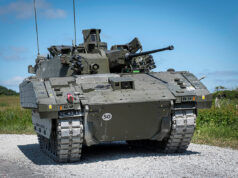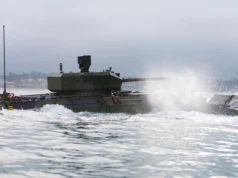According to a recent announcement from the Defense Security Cooperation Agency (DSCA) on August 15, 2024, the U.S. State Department has approved a potential foreign military sale to Denmark involving the purchase of Precision Guidance Kits (PGK) and associated support elements, with an estimated value of $85 million.
Denmark’s request includes up to 5,832 M1156 Precision Guidance Kits, which are designed to enhance the accuracy of 155 mm artillery shells by turning them into precision-guided munitions.
The package also includes ancillary items, compatibility testing, technical assistance, and training, among other logistics and program support elements.
The M1156 PGK, developed by the U.S. Army, functions similarly to the Joint Direct Attack Munition (JDAM) system used on aerial bombs.
The PGK screws into the nose of standard artillery shells, adding a GPS guidance package and control surfaces that allow the shell to adjust its flight path for improved accuracy. This technology has been in production since 2009 and was fielded by the U.S. Army in 2013.
According to the DSCA, “The proposed sale will improve Denmark’s capability to meet current and future threats by providing precision capability equipment and will increase first strike accuracy in its brigades.” The sale is expected to strengthen Denmark’s military capability and interoperability with NATO allies.
The principal contractor for this deal will be Northrop Grumman, based in Minneapolis, Minnesota. The DSCA noted that the sale would not necessitate the deployment of additional U.S. Government or contractor personnel to Denmark.
“This proposed sale will support the foreign policy goals and national security objectives of the United States by improving the security of a NATO Ally that is a force for political stability and economic progress in Europe,” the DSCA added.
The actual cost of the sale may vary depending on final requirements and agreements.













Events in Ukraine make me wonder if this kind of shell isn’t already largely obsolete. Either spend $500 on the dumb shell for wide area supression or a similar amount on an FPV drone for precision attacks and loitering. Why make a dumb shell fairly precise with a $15,000 kit that’s unlikely to work well in a GPS-denied environment?
Defense of stationary positions. EW is largely an area denial technique used for defending a position. If you’re defending it you can control it enough to get rapid precision fires off.
I’ve read that the FPV drones are very inconsistent in damage inflicted on top of being incredibly unreliable – it’s report over 90% of FPV drones from either side never reach a target. When you consider literally hundreds of thousands of them have been built in the last year and a half, the statistic isn’t surprising. Having all your eggs in one basket instead ideal, guided artillery is not obsolete and has recorded massive success in Ukraine. The best results against the massive Russian armoured columns hasn’t been a single system, but multiple combined.
ATGMs for point defense, artillery for saturation, guided shells for individual vehicles, FPV drones acting almost as CAS, MLRS targeting depots ect all at once yielded Ukraines most successful battles. Not just FPV drones.
Because artillery fire is far more effective than FPV drones and it’s more effective again if it’s precision fires…because every shell has to be manufactured, stored and then transported via logistics trains to the artillery…so it’s better if every shell is effective….as for EW…it cannot be everywhere.
These aren’t really that precise, with a CEP of “less than 30m”. If you want to hit a 6m long vehicle, that’s really not good enough. And that’s only if GPS is working, or it’s a whole lot worse. Valuable targets generate bubbles of GPS deniability.
Your argument for as precise as possible doesn’t take the cost into account or Denmark would be buying Excaliburs with a 4m CEP designed to hit targets and not just get somewhere in the general vicinty. Of course they cost $70K a unit.
These kits feel to me like not one thing nor the other. Not precise enough for high-impact precision and not cheap enough for general supression, and then on top of all that you have cheap, high-precision, low-impact drones.
The CEP might be 30m, but the thing is a 155 will kill almost anything in about 50m of it (unlike a FPV). So if you want to hit a 6m truck, and your shell lands 24m away, but the shell will destroy any truck within 60m… not a problem.
There are varying reports of exactly how effective the GPS jamming is, and it certainly isn’t covering the whole front because it would disrupt Russia’s own use of commercial GPS (I’ve heard they don’t only use GLONASS) for their own ops. I don’t believe the bubbles can be all that large either, because a) the power required to pump them out and b) I understand that they’re signals that can be used to home in on the emitter- so you don’t want to be detectable from too far or for too long.
Ground launched SDB has had problems, but air launched has been touted as very effective. GMLRS and JDAM-ER, mixed reports. I’ve heard that GL-SDB was more of a hardware problem associated with separation of the rocket motor than it was the guidance system.
My guess would be that there are two trends that determine accuracy with GPS jamming: speed and range. The further away the item is launched, (especially in a parabolic arc) the sooner it’s going to be adjusting to its particular terminal coordinates and likely outside of the GPS-denial bubble- thus theoretically improving accuracy. The faster the object is moving, the quicker it’ll line up on its coordinates (again, before it hits the GPS-denial bubble) and hit them; terminal micro-adjustments will be made less accurate by the GPS, but by that time it should be largely on track.
So, a 155 mm GPS-guided arty shell fired from 30+ km away should retain a fair chunk of its accuracy (at least in my head!).
With artillery you are usually trying to hit an area not a point target. A CEP of less than 30m is very accurate for area fire – general suppression, if you like to neutralise an enemy company position, a convoy of vehicles, a cluster of buildings etc.
Highly targeted munitions is only a relatively small part of the artillery area of activity – you don’t need them for general suppression.
Also in Ukraine both sides are firing hundreds of thousand rounds a month, so 6k kits would last less than a day.
At peak Russia is firing over 10k a day. The first weeks of the war that number was closer to 60k. Denmark has far fewer batteries so would fire at a much lower rate but still that number wouldn’t last long in a war situation.
I found an article that suggested something like archer can fire realistically around 600 rounds a day. Although I assume practically way lower as your not going to have 600 rounds near by available
Ukraine is expecting to build and use a million drones this year. That’s a hard target. Russia similar. This is of the same order of magnitude as dumb shells, for which I’ve seen a figure of around 2 million on the Ukraine side — although that seemed a pretty vague guesstimate in the context.
Just going to quickly add something:
Drone coverage is very uneven, because we get videos of drone operations uploaded by drone operators, largely for propaganda reasons, we do not see the limitations and restrictions on drones. (Let’s not touch on the question of how much bang you can put into a drone delivered munition vs a 155 shell).
Time into Action is important. Even if all drones can reach their target, and the EW spectrum is clean, and the enemy isn’t monitoring ew emissions and targets your drone teams there is the question of immediacy.
Effectively there’s a scale of time into action,
The fastest is shooting something yourself. Nothing will ever be faster than looking down your sights and pulling a trigger.
The next fastest is calling for direct fire support. “Hey Tank commander, that tree line over there? It needs to be gone.”
Then its IDF; “Artillery, infantry in the open, grid 13908659, one round stand by for correction, come left 100, on, six rounds fire for effect.”
Drones, unless you have them on stand by flying (which maybe if your on the offensive is going to be a thing, but not really) have a reaction time, as the drone team needs to set up, and fly out, which is considerably slower than a precision guided shell.
I totally agree about time to fire. FPV drones are in their infancy and the current methods of use are unwieldy. (Although it must be admitted that launching off a couple of piles of bricks is very cheap.) I’m sure that will change and we’ll get launchers and instant connections for the pilot, if a pilot is still needed. Just training enough FPV drone pilots must be a severe strain for Ukraine.
It won’t change. It’s a fundamental limitation of the tech. Keeping a drone up 24/7 is a great indicator of “SOMEONE IS HERE!!!” in huge letters (never mind the power, signal, and manning constraints that that requires). Which means that the drone team needs to set up and fly the drone out when requested. A 155 crew will slew dozens of shells at an advancing force while a FPV team flies a single drone out. Whether you improve the telemetry, or launcher, doesn’t really change that time from launch to on station to effect on target.
It’s not about the connection to the pilot, it’s simply that you can’t get a Drone to a place where it can have a terminal effect as quickly as you can a shell.
And yes, it is easier to train a gun crew than an FPV operator.
Proof readers on strike ?